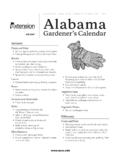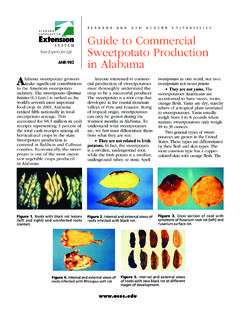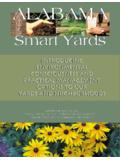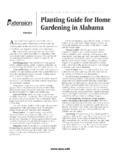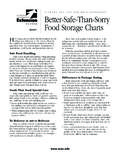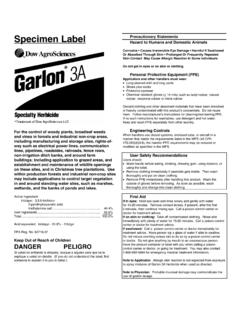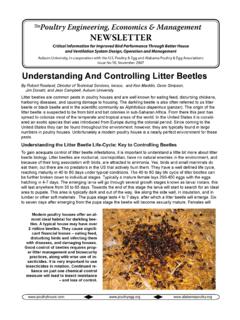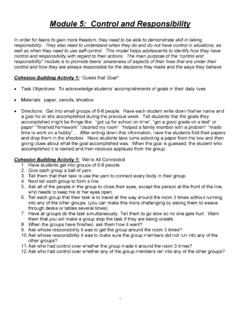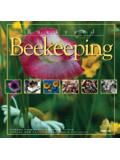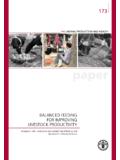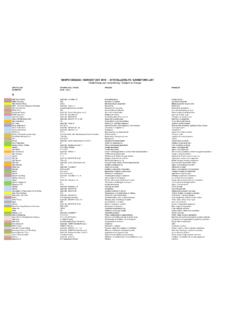Transcription of LIVESTOCK & POULTRY Nutrient Requirements of …
1 L I V E S T O C K & P O U LT R Y. Nutrient Requirements of sheep and Goats Learn the nutritional keys to optimize sheep and goat health at each life stage. The right nutrition provided at the right stage is essential to the profitable production of sheep and goats. It is needed to produce a high-percentage crop, to wean heavy animals, and to develop satisfactory flock replacements. The ideal program also is efficient and economical, and minimizes nutrition-related problems. To succeed, producers should know basic animal nutrition, be familiar with common nutrition terms, and understand nutritional Requirements at different stages of life. This begins with knowing the essential nutrients these small ruminants need energy (fat and carbohydrates), protein, vitamins, minerals, water, and fiber and their roles in growth, production, and reproduction. particularly detrimental to the young animal, so an Essential Nutrients and Their Roles adequate amount must be supplied if rapid growth and high production are to be obtained.
2 On the other Energy hand, excessive feeding is expensive. When protein supplementation is the primary objective, the cost per The best sources of energy for small ruminants are the pound of protein is the most important consideration. most plentiful feeds available. These are usually pastures and browses, hay, and grains. sheep and goats often lack nutrients, however, due to poor-quality pastures and Minerals roughage or inadequate amounts of feed. Because of I n comparison to energy and protein, minerals are this, energy is the most common limiting factor in small necessary in smaller quantities (macro and micro). ruminant nutrition. Deficiency will result in decreased Essential macrominerals (required at or more production, reproductive failure, increased mortality, and in diet) for sheep and goats are calcium, phosphorus, increased susceptibility to diseases and parasites. sodium, potassium, chloride, sulfur, and magnesium.
3 It is essential to evaluate the efficiency and overall Essential microminerals (required in parts per million). performance of a feed or ration referred to as the total include manganese, iron, copper, cobalt, zinc, iodine, digestible nutrients (TDN). TDN is a broad term used selenium, and molybdenum. The primary sources of to express the energy value of a feed or ration. The these minerals are: diet, mineral supplements (loose percentage of TDN is the most widely used method of and block), and, in some areas, the water supply. evaluating feed for energy. As a rule, the greater the Calcium is a necessary constituent of the bones and TDN is in a ration, the greater the rate of gain will be in teeth and is essential for regular heart action and the animal. muscular activity. A calcium deficiency results in poor growth and bone development in growing animals. Protein Phosphorus is an essential part of blood and of all cells Protein is used to repair old tissues and to build new in the body.
4 It is involved in chemical reactions that tissues. In small ruminants, the quantity of protein is release energy in the body. Bones and teeth contain more important than the quality. Protein deficiency is ANR-0812. relatively large amounts of phosphorus as well as Fiber calcium. Both calcium and phosphorus must be present Adequate fiber and/or quality forage promotes good in the ration in the proper proportions. health and better performance. Fiber adds bulk to the Required microminerals (minerals needed in smaller diet and keeps the rumen properly functioning, as it quantities) include iodine, copper, iron, manganese, increases rumination and salivation. The rumen of sheep zinc, molybdenum, cobalt, selenium, and fluoride. These and goats functions best when the daily diet includes a are found in the diet, mineral supplements, and, in some high concentration of slowly degradable fiber ingredients areas, the water supply. Soil quality and pH can be a known as roughage.
5 Extended chewing of the fibrous factor in the availability of macro- and microminerals material helps to keep the acidity in the rumen within a absorbed by vegetation. range that benefits the fiber-digesting microbes. This is commonly known as the cud-chewing process. Vitamins The digestive interaction of fiber stimulates the muscles Vitamins are compounds necessary for normal growth, in the wall of the rumen to contract and expand, which health, and reproduction. Small ruminants require many essentially stirs up the material in the rumen. These vitamins, but their dietary Requirements in this area are forage products include any type of hay, silage, or fresh relatively simple. This is due to the nature of the feeds forage. Cottonseed and soybean hulls often are utilized they ordinarily consume and the synthesis of vitamins in as a form of fiber in feed rations. the rumen. Implementing a Nutritional Program Water To meet the nutritional Requirements of each animal Water functions in the animal body in a number of ways: at its particular stage of life, producers must combine feed ingredients into the least costly but most efficient helps to digest food ration.
6 The following tables provide estimates of the daily regulates body temperature Nutrient needs of sheep and goats. lubricates tissue transports waste from the body Table 1. Daily Nutrient Requirements of sheep (Per Animal). Body Avg. Dry Total % Body TDN Calcium Phosphorous Vitamin Vitamin Weight Daily Matter Protein Weight (lb.) (lb.) (lb.) A (IU) E (IU). (lb.) Gain (lb.) ( ) (lb.). Early-weaned Lambs, Moderate Growth Potential . 22 470 10. 44 940 20. 66 1410 20. 88 1880 22. 110 2350 22. Early-weaned Lambs, Rapid Growth Potential . 22 470 12. 44 940 24. 66 1410 21. 88 1880 22. 110 2350 25. 132 2820 25. 2 alabama cooperative extension system Table 1. Daily Nutrient Requirements of sheep (Per Animal) (cont.). Body Avg. Dry Total % Body TDN Calcium Phosphorous Vitamin Vitamin Weight Daily Matter Protein Weight (lb.) (lb.) (lb.) A (IU) E (IU). (lb.) Gain (lb.) ( ) (lb.). Lambs Finishing, Age 4 7 Months . 66 1410 20. 88 1880 24. 110 2350 24.
7 Replacement Ewe Lambs . 66 1410 18. 88 1880 21. 110 2350 22. 132 2820 22. 154 3290 22. Replacement Ram Lambs . 88 1880 24. 132 2820 26. 176 3760 28. 220 4700 30. Ewes Maintenance 110 2350 15. 132 2820 16. 154 3290 18. 176 3760 20. 198 4230 21. Flushing: 2 Weeks Prebreeding and First 3 Weeks of Breeding 110 2350 24. 132 2820 26. 154 3290 27. 176 3760 28. 198 4230 30. Nonlactating, First 15 Weeks of Gestation 110 2350 18. 132 2820 20. 154 3290 21. 176 3760 22. 198 4230 24. Last 4 Weeks of Gestation (130% 150% Lambing Rate Expected). 110 4250 24. 132 5100 26. 154 5960 27. Nutrient Requirements of sheep and Goats 3. Table 1. Daily Nutrient Requirements of sheep (Per Animal) (cont.). Body Avg. Dry Total % Body TDN Calcium Phosphorous Vitamin Vitamin Weight Daily Matter Protein Weight (lb.) (lb.) (lb.) A (IU) E (IU). (lb.) Gain (lb.) ( ) (lb.). Last 4 Weeks of Gestation (130% 150% Lambing Rate Expected) (cont.). 176 6800 28. 198 7650 30.
8 Last 4 Weeks of Gestation (180% 225% Lambing Rate Expected). 110 4250 26. 132 5100 27. 154 5950 28. 176 6800 30. 198 7650 32. First 6 8 Weeks of Lactation, Suckling Singles 110 4250 32. 132 5100 34. 154 5950 38. 176 6800 39. 198 7650 40. First 6 8 Weeks of Lactation, Suckling Twins 110 5000 36. 132 6000 39. 154 7000 42. 176 8000 45. 198 9000 48. Last 4 6 Weeks of Lactation, Suckling Singles 110 4250 24. 132 5100 26. 154 5960 27. 176 6800 28. 198 7650 30. Last 4 6 Weeks of Lactation, Suckling Twins 110 4250 32. 132 5100 34. 154 5950 38. 176 6800 39. 198 7650 40. Ewe Lambs Nonlactating, First 15 Weeks of Gestation 88 1880 21. 110 2350 22. 132 2820 24. 154 3290 26. 4 alabama cooperative extension system Table 1. Daily Nutrient Requirements of sheep (Per Animal) (cont.). Body Avg. Dry Total % Body TDN Calcium Phosphorous Vitamin Vitamin Weight Daily Matter Protein Weight (lb.) (lb.) (lb.) A (IU) E (IU). (lb.) Gain (lb.) ( ) (lb.)
9 Last 4 Weeks of Gestation (100% 120% Lambing Rate Expected). 88 3400 22. 110 4250 24. 132 5100 26. 154 5950 27. Last 4 Weeks of Gestation (130% 175% Lambing Rate Expected). 88 3400 22. 110 4250 24. 132 5100 26. 154 5960 27. First 6 8 Weeks of Lactation, Suckling Singles (Wean by 8 Weeks). 88 3400 26. 110 4250 32. 132 5100 34. 154 5450 38. First 6 8 Weeks of Lactation, Suckling Twins (Wean by 8 Weeks ). 88 4000 32. 110 5000 34. 132 6000 38. 154 7000 40. Source: National Research Council, 2007. To convert dry matter to an as-fed basis, divide dry matter values by the percentage of dry matter in the particular feed. One pound TDN (total digestible nutrients) = Mcal DE (digestible energy). These are the maximum weight gains expected. These lambs are intended for breeding, so maximum weight gains and finish are of secondary importance. Values are applicable for ewes in moderate condition. Fat ewes should be fed according to the next lower weight category, and thin ewes at the next higher weight category.
10 Once the desired or moderate weight condition is attained, use that weight category through all production stages. Table 2. Required Nutrient Concentrations of sheep Rations (Expressed on 100% Dry Matter Basis ). Body Avg. Dry Total % Body TDN Calcium Phosphorous Vitamin Vitamin Weight Daily Matter Protein Weight (lb.) (lb.) (lb.) A (IU) E (IU). (lb.) Gain (lb.) ( ) (lb.). Early-weaned Lambs, Moderate Growth Potential 22 73 36 427 9. 44 55 23 427 9. 66 52 24 486 7. 88 52 24 570 7. 110 45 24 712 7. Early-weaned Lambs, Rapid Growth Potential 22 85 38 361 9. 44 54 23 361 9. 66 52 23 455 7. Nutrient Requirements of sheep and Goats 5. Table 2. Required Nutrient Concentrations of sheep Rations (Expressed on 100% Dry Matter Basis )(cont.). Body Avg. Dry Total % Body TDN Calcium Phosphorous Vitamin Vitamin Weight Daily Matter Protein Weight (lb.) (lb.) (lb.) A (IU) E (IU). (lb.) Gain (lb.) ( ) (lb.). Early-weaned Lambs, Rapid Growth Potential (cont.)
